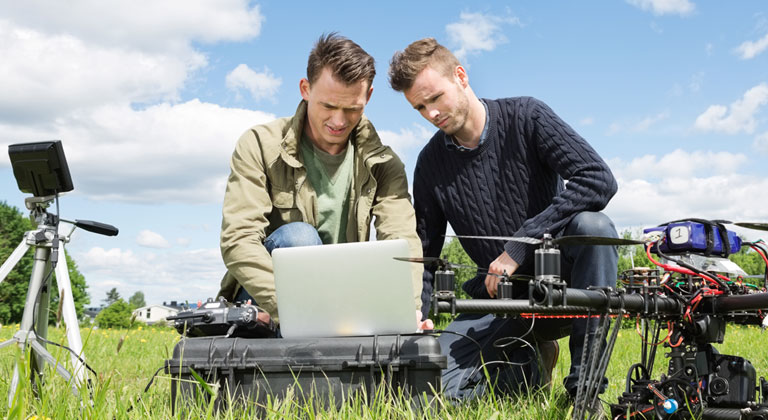Using drones commercially
Clarifying regulations
Commercial use of drones is soaring. And it’s easy to see why. Relatively inexpensive, drones make it possible to capture aerial images that provide valuable data in a variety of industries. Drones are fast becoming standard tools in applications from agriculture to search and rescue.
FAA regulations governing drone use
If you use or are considering using drones in your business, be sure you understand the FAA’s rules governing the use of unmanned aircraft. The following rules impact your use of drones:
Pilot requirements:
At least 16 years old
Pass an aeronautical knowledge test at an FAA-approved knowledge testing center
Vetted by the TSA
Aircraft requirements:
Less than 55 pounds
Registered with the FAA
Operating rules:
Fly in class G airspace. Flying in class B, C, D, and E airspaces allowed with ATC permission.
Keep the aircraft in visual line-of-sight at all times.
Fly under 400 feet.
Fly during the day (30 minutes before official sunrise to 30 minutes after official sunset, local time).
Weather visibility must be at least three miles from pilot’s location.
Fly no more than one unmanned aircraft at a time.
Do not fly an unmanned aircraft from a moving aircraft.
Do not fly an unmanned aircraft from a moving vehicle, unless doing so in a sparsely populated area.
Do not fly in a careless or reckless manner.
Do not transport hazardous materials.
Do not exceed 100 mph.
Yield right-of-way to manned aircraft.
Do not fly over people or moving vehicles not directly participating in your operation.
Please note, you may apply for a waiver to any of these operating rules.
A complete list of rules and regulations can be found on the FAA’s website. If you have any questions about the FAA’s rules or how they apply to your business, seek legal advice or contact the FAA.
Soaring opportunities for commercial drones
Drones are changing the way many companies do business. Drones can help reduce your risk, by providing visual information about a dangerous or hard-to-reach area. By the same token, they can reduce the costs of sending a person on-site or flying a manned aircraft. For many companies, investing in drone technology is a smart financial and risk management decision.
The most common commercial uses of drones include:
Agriculture: Provide real-time images and data to help farmers and agronomists evaluate irrigation, seed timing, and disease rates.
Mining: Conduct surveillance of blasting operations and stockpiles.
Construction: Perform visual inspections of tall structures and evaluate project progress.
Photography and videography: Capture aerial footage for artists, filmmakers, journalists, realtors, and sporting events.
Insurance: Assess damaged roof structures or large scale damage after a catastrophic event.
Insurance considerations for drones
Check with your insurance provider to make sure you’re protected should your drone cause injury or damage to a person or property. There are some insurance extensions available now that address drone-specific exposures related to the ownership, maintenance, and use of drones. At Sentry, our drone extension covers the following uses:
Demonstration
Service and repair
In-flight physical damage
Our drone coverage also features a deductible specific to unmanned aircraft. This eliminates the need for a policy level deductible and provides you with coverage limit and deductible options.
If you use or are thinking about using drones in your business, we can help determine if drone coverage is right for you. To learn more, contact an agent today.
Related resources
Key person insurance
Your top people are some of your top assets. What if you were to lose one of them? Help protect your business with key person insurance.
401(k) investment options
Learn about your investment options and access resources to help you with your investment decisions.
You may like these products
401(k) and other retirement plans, plus life insurance
We’ll work together to help you plan for the future.
Business life insurance
You and your top employees are your business’s most important assets. Protect what you’ve worked so hard to build.
Individual life insurance
If you were to die unexpectedly, would your loved ones be financially secure? Protect your family’s future.






